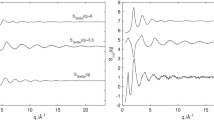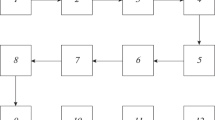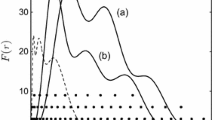Abstract
Hopfield neural network was used to retrieve liquid gallium radial distribution function from an experimental structure factor, obtained at 959 K. The inversion framework was carried out under two initial conditions: (a) a constant radial distribution function corresponding to an ideal gas and (b) a step function, simulating a gas with square well potential of interaction. Both situations lead to accurate inverse results if compared with the radial distribution function obtained by Bellisent-Funel et al., using the Fourier transform method and Monte Carlo simulation. The Hopfield neural network has shown to be a powerful strategy to calculate the radial distribution function from experimental data.






Similar content being viewed by others
References
Singh HB, Holz A (1983) Structure factor of liquid alkali metals. Phys Rev A 28:1108–1113. https://doi.org/10.1103/PhysRevA.28.1108
Yarnell JL, Katz MJ, Wenzel RG, Koenig SH (1973) Structure factor and radial distribution function for liquid argon at 85 K. Phys. Rev. A 7:2130–2144. https://doi.org/10.1103/PhysRevA.7.2130
Gong XG, Chiarotti GL, Parrinello M, Tosatti E (1993) Coexistence of monatomic and diatomic molecular fluid character in liquid gallium. EPL (Europhys Lett) 21:469–475. https://doi.org/10.1209/0295-5075/21/4/015
Narten AH (1972) Liquid gallium: comparison of X-Ray and Neutron-Diffraction data. J Chem Phys 56:1185–1189. https://doi.org/10.1063/1.1677342
Ascarelli P (1966) Atomic radial distributions and ion-ion potential in liquid gallium. Phys Rev 143:36–47. https://doi.org/10.1103/PhysRev.143.36
Yagafarov OF, Katayama Y, Brazhkin VV, Lyapin AG, Saitoh H (2012) Energy dispersive X-ray diffraction and reverse Monte Carlo structural study of liquid gallium under pressure. Phys Rev B 86:174103–1–174103-9. https://doi.org/10.1103/PhysRevB.86.174103
Lemes NHT, Borges E, Sousa RV, Braga JP (2008) Potential energy function from differential cross-section data: an inverse quantum scattering theory approach. Int J Quantum Chem 108:2623–2627. https://doi.org/10.1002/qua.21701
Sebastião R C O, Pacheco CN, Braga JP, Piló-Veloso D (2006) Diffusion coefficient distribution from NMR-DOSY experiments using Hopfield neural network. J Magn Reson 182:22–28. https://doi.org/10.1016/j.jmr.2006.06.005
Neves JL, Braga JP, Braga AP, de Almeida MB (2002) Recurrent neural network model to retrieve the long range spherical potential energy function from second virial coefficient. Inverse probl Eng 10:153–162. https://doi.org/10.1080/10682760290004302
Carvalho FS, Braga JP, Alves MO, Gonçalves C E M (2020) Neural network in the inverse problem of liquid argon structure factor: from gas-to-liquid radial distribution function. Theor Chem Acc 139:29. https://doi.org/10.1007/s00214-019-2531-1
Hopfield JJ (1982) Neural networks and physical systems with emergent collective computational abilities. Proc Natl Acad Sci 79:2554–2558. https://doi.org/10.1073/pnas.79.8.2554
Lemes NHT, Borges E, Braga JP (2007) A general algorithm to solve linear and nonlinear inverse problems. J Braz Chem Soc 18:1342–1347. https://doi.org/10.1590/S0103-50532007000700008
Bellissent-Funel MC, Chieux P, Levesque D, Weis JJ (1989) Structure factor and effective two-body potential for liquid gallium. Phys Rev A 39:6310–6318. https://doi.org/10.1103/PhysRevA.39.6310
Scherm R (1972) Fundamentals of neutron scattering by condensed matter. Ann Phys 14:349–370
Powell JL, Crasemann B (1961) Quantum mechanics. Addison-Wesley Publishing, London
Egami T, Billinge SJL (2003) Underneath the Bragg peaks: structural analysis of complex materials. Elsevier, New York
Hansen JP, McDonald IR (1990) Theory of simple liquids. Academic Press, New York
Hopfield JJ, Tank DW (1985) “Neural” computation of decisions in optimization problems. Biol Cybern 52:141–152. https://doi.org/10.1007/BF00339943
Funding
The authors receive financial support from CNPq.
Author information
Authors and Affiliations
Corresponding author
Additional information
Publisher’s note
Springer Nature remains neutral with regard to jurisdictional claims in published maps and institutional affiliations.
This paper belongs to Topical Collection XX-Brazilian Symposium of Theoretical Chemistry (SBQT2019)
Rights and permissions
About this article
Cite this article
Carvalho, F.S., Braga, J.P. Radial distribution function for liquid gallium from experimental structure factor: a Hopfield neural network approach. J Mol Model 26, 193 (2020). https://doi.org/10.1007/s00894-020-04436-y
Received:
Accepted:
Published:
DOI: https://doi.org/10.1007/s00894-020-04436-y




